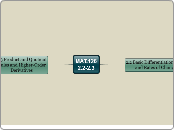MAT.126
2.2-2.3
2.2 Basic Differentiation Rules and Rates of Change
Find the derivative of a function using the Constant Rule
Find the derivative of a function using the Power Rule
x
Rewriting
Evaluating the derivative to find the slope at a point
Finding the equation of a tangent line
Find the derivative of a function using the Constant Multiple Rule
Using parentheses when differentiating
Find the derivative of a function using the Sum and Difference Rules
Find the derivatives of the sine function and of the cosine function
Use derivatives to find rates of change
2.3 Product and Quotient Rules and Higher-Order Derivatives
Find the derivative of a function using the Product Rule
Find the derivative of a function using the Quotient Rule
Algebra!
Use lots of parentheses
Rewrite when necessary
Constant Multiple Rule
Simplify
Find the derivative of a trigonometric function
Trigonometric Identities
Find a higher-order derivative of a function
